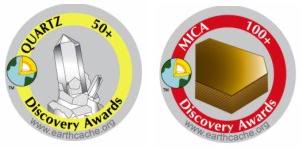Almosta Trail Xenoliths EarthCache
-
Difficulty:
-

-
Terrain:
-

Size:  (other)
(other)
Please note Use of geocaching.com services is subject to the terms and conditions
in our disclaimer.

Site #1
Igneous rocks which are formed from molten rock below the surface of the Earth (magma) are called intrusive. Intrusive rocks are characterized by large individual crystal sizes which can be seen with the naked eye. Cooling of molten rock within the Earth is typically slower than molten rock cooling processes at the surface, which lends to larger crystal growth within the rock. Rocks with visible crystals of roughly the same size are said to have a phaneritic texture. The most common intrusive type rock is granite (plutonic).
Igneous rocks which are formed from molten rock above the surface of the Earth (lava) are called extrusive. Extrusive rocks are characterized by fine-grained textures because of their rapid cooling and stunted crystal growth. Rocks with this fine-grained texture are called aphanitic. The most common extrusive type rock is basalt (volcanic).

Site #2
The word xenolith is most commonly used to describe an inclusion which has become trapped within igneous type rock during molten rock emplacement or eruption. To a lesser extent it is sometimes used to describe rock fragments which have become encased in sedimentary type rock formations or those found in some meteorites. To be a true xenolith, the included rock must be identifiably different from the rock that has enveloped it. An included rock of similar type or minerology is called an autolith or a cognate inclusion.
In igneous type rocks, xenoliths become trapped within molten rock flows in several different manors. One being that these random rocks are torn loose from the walls of a lava chamber (under ground) by a passing flow and carried away within that flow. Another being that they were originally random rocks strewn across the top of the Earth's surface that became engulfed within, and carried away, in the base of a passing lava flow.
There are many reasons why the rock fragments might not have been consumed by the super heated molten rock. One reason being that the inclusion might have a higher melting point temperature than the temperature of the molten rock flow. Basalt, for one, has a very high melting point temperature and might not be consumed if it is the rock type fragment in question. Alternatively, the inclusion might not have had enough time to melt/assimilate if it was included soon before the molten rock cooled and crystallized. In either case the inclusion could be composed of any rock or mineral type.
The coordinates given are for parking. It is a short, flat trail hike to the 2 waypoints which are not far from each other. Each waypoint has a different type of xenolith contained within. Since some of the rocks in the area have multiple types of inclusions, I have added photos to show the "exact" xenolith on each of the rocks to be used to answer the questions. Note the signage in each photo to assist in locating the right rock. Email your answers to the questions, to me, using the link in my profile only. If your answers are not received by me, your log will be deleted. Photos are accepted and appreciated as long as the answers are not pictured. You do not have to wait for confirmation from me before logging this cache as completed. Most of all……learn……and enjoy the view.
1. At site #1, is the parent rock plutonic or volcanic?
2. At site #1, is the inclusion a xenolith or an autolith?
3. At site #1, what is the size and shape of the inclusion?
4. At site #1, what type rock/mineral do you believe the inclusion consists of?
5. At site #1, is the xenolith a cognate inclusion?
6. At site #2, is the parent rock aphanitic or phaneritic?
7. At site #2, is the inclusion a xenolith or an autolith?
8. At site #2, what is the size and shape of the inclusion?
9. At site #2, does the inclusion protrude above the parent rock or is it recessed into the parent rock? What would cause this?
 Placement permission granted by
Placement permission granted by
Brandon Shoults
Yavapai County Facilities Department
(928) 771-3115
Additional Hints
(No hints available.)